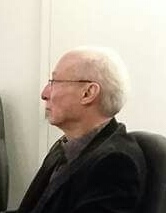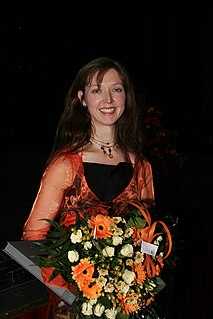Ned Bouhalassa is a composer of film scores, television scores, and electroacoustic music. Bouhalassa is a Canadian citizen, and has been living in Montreal since 1967.
Denis Arthur Smalley is a composer of electroacoustic music, with a special interest in acousmatic music.
Founded in 1986, La Communauté électroacoustique canadienne / The Canadian Electroacoustic Community (CEC) is Canada's national electroacoustic / computer music / sonic arts organization and is dedicated to promoting this progressive art form in its broadest definition: from "pure" acousmatic and computer music to soundscape and sonic art to hardware hacking and beyond.
Hildegard Westerkamp is a Canadian composer, radio artist, teacher and sound ecologist of German origin. She studied flute and piano at the Conservatory of Music in Freiburg, West Germany from 1966 to 1968 and moved to Canada in 1975. She received a Bachelor of Music from the University of British Columbia in 1972 and a Master of Arts from Simon Fraser University in 1988. She taught acoustic communication at Simon Fraser University from 1982 to 1991.
Francis Dhomont is a French composer of electroacoustic / acousmatic music.
Christian Calon is a French-born Canadian composer who is active in electroacoustic music. He has worked extensively in large computer-based studios in Canada and Europe and has received commissions from the Canada Council, the Groupe de Musique Expérimentale de Marseille, and the Ministère des Affaires culturelles du Québec. His work is written in an expressionist and narrative style and his pieces are characterized by acousmatic diffusion.

Yves Daoust is a Canadian composer who is particularly known for his works of electroacoustic music. He currently resides in Montréal.
Paul Dolden, is an electroacoustic music composer, currently living in Montréal, Canada.
Louis Dufort is a Canadian composer of electroacoustic music. He was born and lives in Montréal, Canada.
Gilles Gobeil is an electroacoustic music composer from Sorel-Tracy, Quebec, Canada, and currently living in Montreal, Quebec, Canada. Gobeil received his musical education at the Université de Montréal.
Jonty Harrison is an electroacoustic music composer born 27 April 1952 in Scunthorpe, UK, and currently living in Birmingham, UK.

Robert Normandeau is a Canadian electroacoustic music composer.
Stéphane Roy is a Canadian electroacoustic music composer and writer on music. An associate composer of the Canadian Music Centre, his works have received awards from international competitions in Canada, the USA, and Europe. He currently teaches electroacoustic techniques and auditory perception at the Université de Montréal and is also a faculty member at the Conservatoire de musique du Québec à Montréal. He is the current vice-president of the Canadian Electroacoustic Community He lives in Greenfield Park, Quebec, Canada.
Adrian Moore is an electroacoustic music composer born January 1969 in Nottingham, UK, and currently living in Sheffield, UK. He is director of the University of Sheffield Sound Studios.
John Young is an electroacoustic music composer born March 4, 1962, in Christchurch, New Zealand, and currently living in Leicester, UK.
Live electronic music is a form of music that can include traditional electronic sound-generating devices, modified electric musical instruments, hacked sound generating technologies, and computers. Initially the practice developed in reaction to sound-based composition for fixed media such as musique concrète, electronic music and early computer music. Musical improvisation often plays a large role in the performance of this music. The timbres of various sounds may be transformed extensively using devices such as amplifiers, filters, ring modulators and other forms of circuitry. Real-time generation and manipulation of audio using live coding is now commonplace.

Natasha Barrett is a British contemporary music composer specialising in electroacoustic art music. Her compositional aesthetics are derived from acousmatic issues. In addition to acousmatic concert music, she composes for instruments, live electronics, sound installations, multi-media works, real-time computer music improvisation, has made soundscapes for exhibitions, and music for contemporary dance and theater. Since 2000 her work has been influenced by spatialisation as a musical parameter, and the projection of 3-D sound-fields. She currently lives in Norway.

Patrick Ascione was a French composer of electroacoustic and acousmatic music.

Arne Eigenfeldt is a Canadian composer and creator of interactive and generative music systems based in Vancouver, British Columbia. Both his music and his research into intelligent systems have been presented internationally. He is currently a professor of music at Simon Fraser University. He also produces electronica under the pseudonyms Raemus and loadbang.
Spatial music is composed music that intentionally exploits sound localization. Though present in Western music from biblical times in the form of the antiphon, as a component specific to new musical techniques the concept of spatial music was introduced as early as 1928 in Germany.




